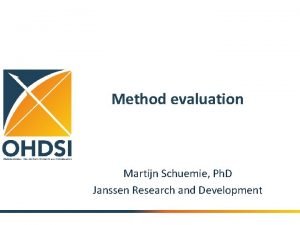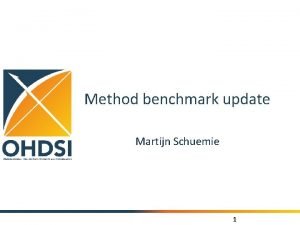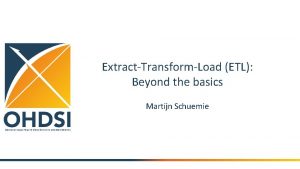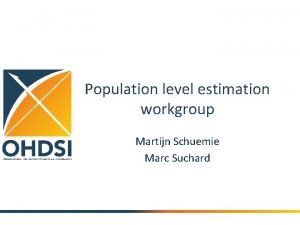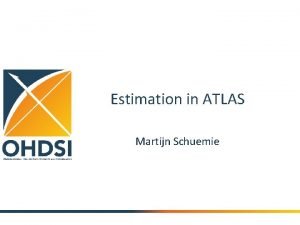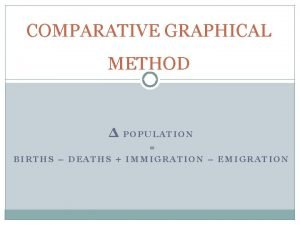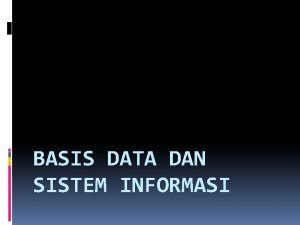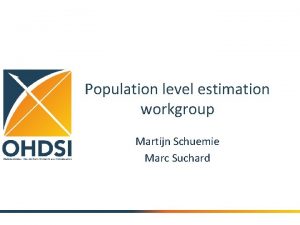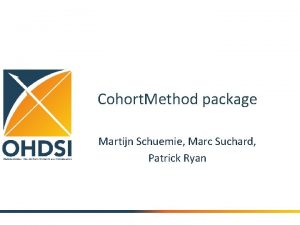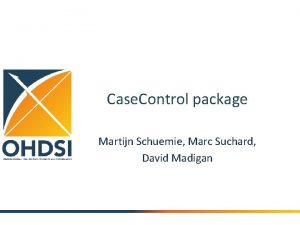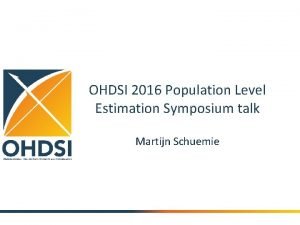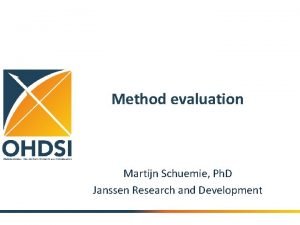Population level estimation workgroup Martijn Schuemie Marc Suchard














- Slides: 14

Population level estimation workgroup Martijn Schuemie Marc Suchard

What is population-level estimation? • Does exposure to A increase the risk of outcome X compared to exposure to B? 2

Workgroup meetings Western hemisphere Eastern hemisphere

Workgroup wiki

Objective Develop scientific methods for observational research leading to population level estimates that are accurate, reliable, and reproducible, and facilitate the use of these methods by the community. Specific goals: • Specify OHDSI Best Practices for Estimating Population-Level Effects • Develop the Methods library 5

Best practices >= 10 guidelines on how to do population-level estimation: 1. AHRQ: Developing a Protocol for Observational Comparative Effectiveness Research All other guidelines. Research are vague Collaborative: and non-prescriptive, 2. Comparative Effectiveness Observational Study Assessment Questionnaire especially about which methods to use. 3. ENCe. PP Checklist for Study Protocols OHDSIon guidelines will be prescriptive, we think 4. ENCe. PP Guide Methodological Standardsand in Pharmacoepidemiology researchers should justify they deviate from. Practices best 5. FDA: Guidance for Industry Good why Pharmacovigilance and practices when they do. Pharmacoepidemiologic Assessment 6. Good Rese. Arch for Comparative Effectiveness (GRACE) Checklist 7. GRACE Principles 8. ISPOR Good Research Practices for Retrospective Database Analysis Task Force Report 9. PCORI Methodology Standards 10. ISPE Guidelines for good pharmacoepidemiology practices (GPP) 11. OHDSI Best Practices for Population-Level Estimation 6

Best practices are on the Wiki Workgroup verdict: We need empirical evidence to support some of the proposed best practices E. g. Large scale regularized regression for propensity scores requires evidence it is better than other approaches 7

Development Methods library: • Methods: Available as open source R packages Run against the CDM – Cohort. Method – Self. Controlled. Case. Series – Case. Control – Self. Controlled. Cohort – ICTemporal. Pattern. Discovery • Empirical. Calibration • Method. Evaluation 8

Development Novel methods: • Advanced approaches to propensity scores • Comparative SCCS

Method Evaluation Task Force 1. Develop the methodology for evaluating methods 2. Use the developed methodology to systematically evaluate a large set of study designs and design choices. To inform best practices

OMOP Experiment

Lessons learned from OMOP Issues with the OMOP experiment(s): • Problem with know positive controls (especially contra-indication) that artificially favors selfcontrolled designs • Limitations in methods library – Forgot to censor in SCC – MSCCS applied shrinkage to exposure of interest – Cohort. Method did not correct for differences in length of follow up • Uncertainty around positive and negative status • Don’t know true RR if RR != 1 12

Must specify 3 components Methods Gold standard (Exposure-Outcome pairs) Data 13

Gold standard • Real negative controls • Synthetic positive controls • Recent RCTs: use only data from before
 Martijn schuemie
Martijn schuemie Martijn schuemie
Martijn schuemie Martijn schuemie
Martijn schuemie Martijn schuemie
Martijn schuemie Martijn schuemie
Martijn schuemie Marc suchard
Marc suchard Martijn schuemie
Martijn schuemie Philippe sucharda
Philippe sucharda Schokolade herstellung
Schokolade herstellung Curvilinear method population estimation
Curvilinear method population estimation Domain vs workgroup
Domain vs workgroup Workgroup sphere of influence
Workgroup sphere of influence Workgroup sphere of influence
Workgroup sphere of influence Diff between workgroup and domain
Diff between workgroup and domain Personal computer database vs workgroup database
Personal computer database vs workgroup database
